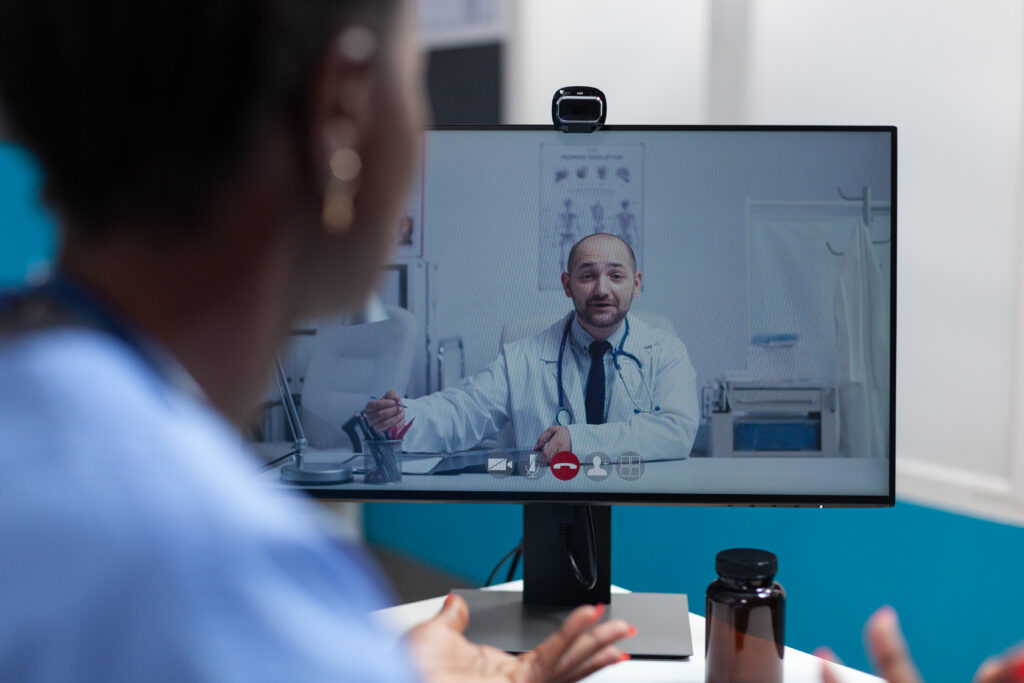By 2025, telemedicine has become a strong, long-lasting pillar of contemporary healthcare, transcending its status as a pandemic-driven necessity. Virtual healthcare is transforming the way patients and medical professionals communicate, from standard consultations to specialized care. Telemedicine is changing how healthcare is delivered in the future thanks to its cutting-edge technology, increased accessibility, and growing acceptance.
The definition of telemedicine, its function in healthcare, the kinds of telemedicine services that are offered, and the developments that will change virtual care in 2025 will all be covered in this article.
What is the Meaning of Telemedicine?
The term “telemedicine” describes the use of telecommunications technology to diagnose and treat patients remotely. With the use of technologies like video conferencing, smartphone apps, and remote monitoring devices, it enables medical professionals to assess, diagnose, and treat patients remotely.
Although the terms “telemedicine” and “telehealth” are frequently used interchangeably, telehealth refers to a wider range of services, including non-clinical ones like continuing medical education, administrative meetings, and training.
A Simple Definition of Telemedicine
To put it simply, telemedicine allows you to see your doctor without physically going to the clinic. From the comfort of your home, you can connect via your computer, tablet, or smartphone to receive follow-ups, prescriptions, or medical advice.

The Role of Telemedicine in Healthcare
Telemedicine will be essential at every stage of the healthcare system in 2025. Here’s how:
1. Making Care More Accessible
For those living in remote or underserved areas, telemedicine fills the gap. It makes it possible for patients to see doctors without having to travel far, particularly in areas with a lack of medical facilities.
2. Cutting Medical Expenses
For both patients and providers, virtual consultations may be less expensive than in-person visits. They reduce hospital and clinic operating costs, travel expenses, and time off work.
3. Handling Long-Term Conditions
Regular telemonitoring is very beneficial for patients with long-term conditions like diabetes, hypertension, or COPD. Vitals are tracked by wearable technology, and real-time data sharing with healthcare providers enables proactive treatment.
4. Enhancing Patient Engagement
Telemedicine encourages patients to take a more active role in their healthcare. Tools like mobile health apps and patient portals make it easier to schedule appointments, access records, and communicate with providers.
5. Streamlining Mental Health Support
Online therapy and counseling have surged in popularity. Telepsychiatry offers easier access to mental health professionals, especially for those uncomfortable with in-person visits.
Types of Telemedicine Services in 2025
There is no one-size-fits-all approach to telemedicine. Various kinds exist, contingent on the type of service and interaction:
1. Interactive Real-Time Services
This is the most prevalent kind, which involves live audio or video calls between patients and medical professionals. Primary care, follow-ups, urgent care, and mental health counseling are among its uses.
2. RPM, or remote patient monitoring
RPM gathers and transmits health data, such as blood pressure, heart rate, and glucose levels, to medical professionals in real time via connected devices. When it comes to managing chronic illnesses, it is invaluable.
3. Telemedicine that stores and forwards
This entails providing medical information (such as X-rays, test results, and pictures) to experts for review at a later date. It is frequently utilized in pathology, radiology, and dermatology.
4. mHealth, or mobile health
These are mobile apps that offer health services and information. Medication reminders, symptom monitoring, wellness advice, and doctor communication are all included in mHealth.
Telemedicine Trends in 2025
Looking at the state of telemedicine in 2025, we can see that the following evolutionary trends are influencing the sector:
1. Diagnostics Driven by AI
Faster and more precise diagnosis is being supported by artificial intelligence. AI is capable of analyzing patient data, forecasting possible health hazards, and even making treatment recommendations.
2. Augmented reality (AR) and virtual reality (VR)
Through immersive experiences, VR and AR are being used for pain management, surgical training, and remote physical therapy.
3. Wearables Integration
Telehealth platforms integrate medical-grade wearables, fitness trackers, and smartwatches to enable remote intervention and real-time health tracking.
4. Expanded Insurance Protection
More insurance companies will offer telemedicine services as standard coverage by 2025. The United States’ Medicare and Medicaid programs now offer more virtual care options.
5. Enhanced Security of Data
Strong cybersecurity measures are in place to safeguard patient data and guarantee HIPAA compliance as a result of the increasing use of digital platforms.
Benefits of Telemedicine for Patients
- Convenience: No need to wait in clinics or travel
- Time-saving: Quicker access to medical attention
- Cost-effective: Lower medical costs
- On-demand care from online urgent care platforms is available around-the-clock.
- Improved Continuity: Simple management of persistent conditions and follow-ups
Top Telemedicine Platforms in 2025
The following are a few of the most widely used virtual care platforms available today:
- Teladoc Health provides services for chronic illnesses, mental health, and general health.
- Board-certified physicians are available around-the-clock through MDLIVE.
- Amwell is well-known for teletherapy and behavioral health.
- Video consultations with certified medical professionals and therapists are available through Doctor on Demand.
- AI-powered symptom checkers and doctor access are features of HealthTap.
Commonly Asked Questions About Telemedicine in 2025
Is in-person care more effective than telemedicine?
Indeed. According to studies, telemedicine is equally as effective as in-person visits for a variety of care types, particularly routine consultations, chronic disease management, and mental health.
Is it possible to administer prescriptions via telemedicine?
Of course. Following a virtual consultation, licensed physicians can write prescriptions, which can then be sent straight to your preferred pharmacy.
Indeed. Platforms for telemedicine adhere to stringent regulations for data security and patient privacy. Always pick a healthcare provider who abides by HIPAA and other laws.
Is it possible to use telemedicine without insurance?
Indeed. If you don’t have insurance, many platforms provide reasonable out-of-pocket costs.
The Future of Telemedicine
With the development of new technologies like blockchain, 5G connectivity, and personalized medicine, telemedicine will likely continue to change in the future. Global virtual healthcare networks, expanded robotic telesurgery, and AI-powered virtual assistants could all be developments in the near future.
To ensure that telemedicine becomes a sustainable, scalable solution for healthcare access, governments and healthcare providers around the world are investing in digital health infrastructure.



